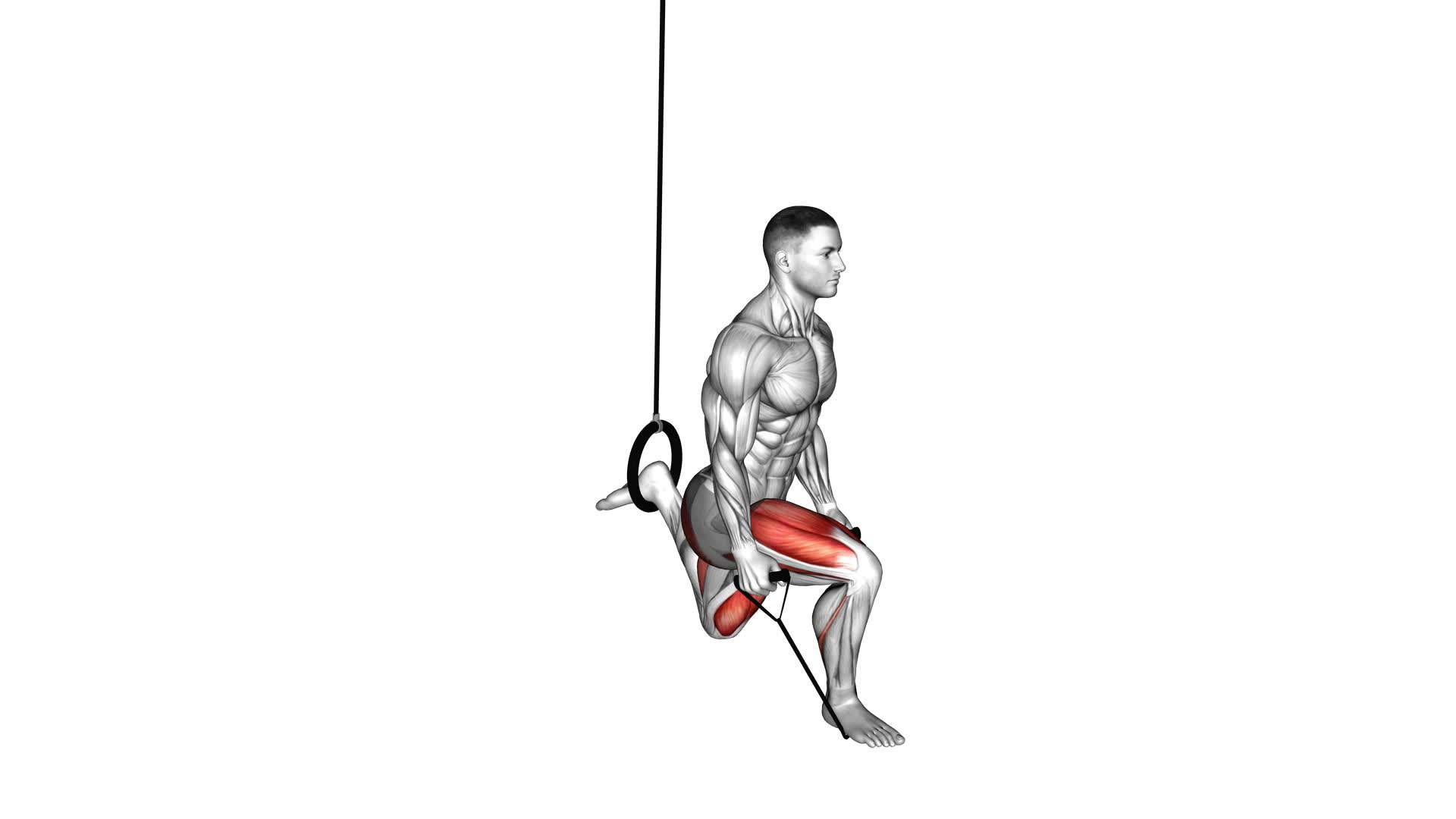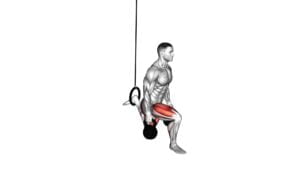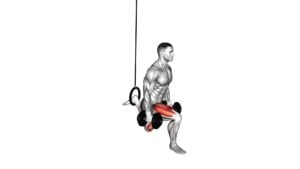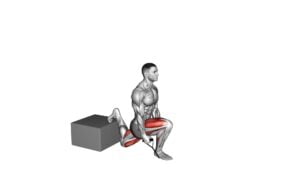Band Single Leg Split Squat With the Ring – Video Exercise Guide & Tips

Are you looking for an effective lower body exercise that will challenge your stability and strength? Look no further than the band single leg split squat with the ring.
Watch This Exercise Video
This exercise targets your glutes, quads, and hamstrings, while also improving your balance and coordination. In this article, you'll find a video exercise guide and helpful tips to ensure you perform this exercise correctly and get the most out of your workout.
Get ready to take your leg workout to the next level!
Key Takeaways
- Targets glutes, quads, and hamstrings
- Improves balance, coordination, and stability
- Reduces the risk of falls and injuries
- Strengthens and tones glute muscles
Benefits of the Band Single Leg Split Squat
What are the key benefits of performing the Band Single Leg Split Squat?
The Band Single Leg Split Squat is an effective exercise for improving balance and targeting the glute muscles. By performing this exercise, you can enhance your stability and strengthen your glutes, which play a crucial role in overall lower body strength.
Improving balance is one of the main benefits of the Band Single Leg Split Squat. This exercise requires you to stand on one leg while performing a squat motion, which challenges your body's ability to maintain stability. By regularly incorporating this exercise into your routine, you can enhance your balance and stability, reducing the risk of falls and injuries.
In addition to improving balance, the Band Single Leg Split Squat also targets the glute muscles. As you lower your body into the squat position, the glute muscles are engaged to stabilize your body and power the movement. By consistently performing this exercise, you can strengthen and tone your glutes, leading to improved lower body strength and aesthetics.
Now that you understand the benefits of the Band Single Leg Split Squat, let's move on to discussing proper form and technique to ensure you get the most out of this exercise.
Proper Form and Technique
To perform the Band Single Leg Split Squat with proper form and technique, you need to focus on your posture and balance. Here are some important tips to keep in mind:
- Keep your chest up and shoulders back: This helps maintain a neutral spine and prevents rounding of the back, which is a common mistake. It also engages your core and stabilizes your upper body.
- Maintain a straight front leg: Make sure your front knee doesn't collapse inward or extend past your toes. This ensures proper alignment and prevents strain on your knee joint.
- Control your descent and ascent: Avoid rushing through the movement. Lower yourself down slowly, keeping tension on the working leg, and push through your heel to come back up. This helps build strength and stability.
Common misconceptions about the Band Single Leg Split Squat include thinking that it's only a lower body exercise. In reality, it also challenges your core and improves your balance. Additionally, many people mistakenly believe that using heavier resistance bands will lead to better results. However, it's important to choose a band that allows you to maintain proper form and complete the exercise with control.
Now that you know how to perform the Band Single Leg Split Squat with proper form and technique, let's move on to the equipment needed for the exercise.
Equipment Needed for the Exercise
You will need one resistance band and a sturdy ring for the Band Single Leg Split Squat exercise. Having the right equipment is crucial for effectively performing this exercise and avoiding injuries.
Before starting the exercise, it's important to warm up your muscles to increase blood flow and flexibility. This can be done through dynamic stretches or light cardio exercises. Warming up prepares your body for the workout, reduces the risk of injury, and improves overall performance.
When performing the Band Single Leg Split Squat, there are common mistakes that you should try to avoid. One common mistake isn't maintaining proper form and technique. It's important to keep your back straight, chest up, and core engaged throughout the exercise.
Another mistake is using too much resistance or weight, which can compromise your form and increase the risk of injury. Start with a lighter resistance band and gradually increase as you become more comfortable and stronger.
Modifications for Beginners
If you're a beginner, you can modify the Band Single Leg Split Squat exercise by using a lighter resistance band and focusing on mastering proper form and technique. Here are three modifications to help beginners get started:
- Use a lighter resistance band: Instead of using a heavy resistance band, start with a lighter one. This will allow you to focus on getting the movement right without putting too much strain on your muscles.
- Master proper form: Before adding any resistance, make sure you have the correct form and technique. This includes maintaining proper alignment, keeping your core engaged, and ensuring your knee doesn't go past your toes.
- Start with a shorter range of motion: If you're finding it difficult to perform the exercise with a full range of motion, start by performing a partial split squat. Gradually increase the depth as you become more comfortable and confident.
Advanced Variations to Challenge Yourself
For a more challenging workout, try incorporating advanced variations of the Band Single Leg Split Squat exercise. These advanced modifications are designed to increase the difficulty and take your lower body strength and stability to the next level.
One advanced variation you can try is the Weighted Band Single Leg Split Squat. Instead of using just the resistance band, hold a dumbbell or kettlebell in one hand while performing the exercise. This added weight will challenge your muscles even more, helping to build strength and endurance.
Another advanced modification is the Plyometric Band Single Leg Split Squat. Instead of performing the exercise in a slow and controlled manner, explode upwards as you push off the ground, switching legs in mid-air and landing softly. This explosive movement won't only challenge your muscles but also improve your power and agility.
These advanced variations will push your limits and provide a more intense workout.
To maximize the effectiveness of the exercise, it's important to maintain proper form and technique. Keep your chest up, core engaged, and back straight throughout the movement. Focus on controlling the descent and driving through your front heel as you come up. Additionally, make sure to breathe properly, inhaling as you lower yourself down and exhaling as you push back up.
Tips to Maximize the Effectiveness of the Exercise
To maximize the effectiveness of the Band Single Leg Split Squat with the Ring, it's important to focus on proper form. Keep your back straight, chest lifted, and engage your core throughout the exercise.
Additionally, pay attention to your breathing, exhaling as you push through your heel to stand back up.
As you progress, gradually increase the resistance by using a stronger band or adding weights to challenge your muscles even more.
Proper Form Importance
Maintain proper form to maximize the effectiveness of the Band Single Leg Split Squat with the Ring exercise. Proper form is essential for targeting the correct muscles and preventing injury. Here are some tips to help you achieve the best results:
- Importance of balance: Focus on keeping your weight evenly distributed between your front and back foot. This will help engage your core and stabilize your body throughout the exercise.
- Common mistakes to avoid: Avoid leaning too far forward or backward, as this can put unnecessary strain on your lower back and knees. Keep your torso upright and aligned with your hips to maintain proper form.
- Engage your glutes: Throughout the movement, consciously squeeze your glutes to activate the muscles and maximize the effectiveness of the exercise.
Breathing Techniques for Stability
As you focus on maintaining proper form and maximizing the effectiveness of the Band Single Leg Split Squat with the Ring exercise, it's important to incorporate proper breathing techniques for stability. Breathing plays a crucial role in engaging your core and maintaining proper body alignment throughout the exercise.
When performing the squat, inhale deeply through your nose as you lower your body down. This helps to engage your core muscles and stabilize your body.
As you exhale through your mouth, push through your heel and drive your body back up to the starting position. This controlled breathing pattern helps to maintain stability and control throughout the exercise, allowing you to effectively target your leg muscles and improve overall strength and balance.
Remember to focus on your breath as you perform the Band Single Leg Split Squat with the Ring for maximum effectiveness.
Increasing Resistance for Progress
To further enhance the effectiveness of the Band Single Leg Split Squat with the Ring exercise, you can increase resistance for greater progress and optimal results. Here are three tips to help you increase intensity and maximize muscle activation:
- Use a stronger resistance band: By using a band with higher resistance, you challenge your muscles to work harder during the exercise. This increased resistance will help you build strength and promote muscle growth.
- Add weights: Holding dumbbells or kettlebells while performing the Band Single Leg Split Squat can further increase the difficulty of the exercise. The additional weight puts more demand on your muscles, leading to greater gains in strength and muscle activation.
- Slow down the movement: Slowing down the tempo of the exercise can also increase the intensity. By taking more time to lower yourself into the squat and return to the starting position, you engage your muscles for a longer duration, resulting in enhanced muscle activation and improved overall workout effectiveness.
Frequently Asked Questions
How Many Sets and Repetitions Should I Do for the Band Single Leg Split Squat?
To determine the number of sets and repetitions for the band single leg split squat, consider your fitness level and goals. Start with 2-3 sets of 8-12 repetitions per leg.
As you build strength and endurance, you can increase the number of sets or repetitions. Remember to listen to your body and modify the exercise if needed.
Consulting a fitness professional can provide additional variations and modifications tailored to your specific needs.
Is It Necessary to Use a Resistance Band for This Exercise, or Can I Perform It Without One?
Yes, it's necessary to use a resistance band for this exercise. The band adds extra resistance, which helps to strengthen your leg muscles more effectively. It also provides stability and support to your body during the movement.
However, if you don't have a resistance band, you can modify the exercise by using dumbbells or simply performing the split squat without any additional equipment.
Remember to maintain proper form and control throughout the exercise for maximum benefits.
Can the Band Single Leg Split Squat Be Done as a Warm-Up Exercise Before a Lower Body Workout?
Yes, the band single leg split squat can be a great warm-up exercise before your lower body workout. It helps activate your muscles and increase blood flow, preparing your body for more intense exercises.
This exercise specifically targets your quads, glutes, and hamstrings, helping to improve strength and stability in your lower body.
Is It Safe to Perform This Exercise if I Have Knee or Hip Issues?
If you have knee or hip issues, it's important to prioritize safety when performing exercises.
Before attempting the Band Single Leg Split Squat, consult with a healthcare professional or physical therapist to determine if it's suitable for your condition.
They can provide modifications or alternative exercises that can provide similar benefits while minimizing the strain on your knees and hips.
Can I Incorporate This Exercise Into a Full-Body Workout Routine, or Is It Best to Focus Solely on Lower Body Exercises When Doing the Band Single Leg Split Squat?
Incorporating the band single leg split squat into a full-body workout routine can be a great idea. It allows you to target your lower body while also engaging your core and stabilizer muscles.
Plus, adding resistance bands to the exercise can increase the intensity and challenge your muscles even more.
Conclusion
In conclusion, the band single leg split squat is a highly effective exercise for strengthening and toning the lower body. It targets the glutes, quads, and hamstrings while also improving balance and stability.
By using a resistance band, you can increase the intensity of the exercise and challenge yourself further. Remember to maintain proper form and technique to prevent injuries.
Incorporate this exercise into your workout routine for maximum results.

Author
Years ago, the spark of my life’s passion ignited in my mind the moment I stepped into the local gym for the first time. The inaugural bead of perspiration, the initial endeavor, the very first surge of endorphins, and a sense of pride that washed over me post-workout marked the beginning of my deep-seated interest in strength sports, fitness, and sports nutrition. This very curiosity blossomed rapidly into a profound fascination, propelling me to earn a Master’s degree in Physical Education from the Academy of Physical Education in Krakow, followed by a Sports Manager diploma from the Jagiellonian University. My journey of growth led me to gain more specialized qualifications, such as being a certified personal trainer with a focus on sports dietetics, a lifeguard, and an instructor for wellness and corrective gymnastics. Theoretical knowledge paired seamlessly with practical experience, reinforcing my belief that the transformation of individuals under my guidance was also a reflection of my personal growth. This belief holds true even today. Each day, I strive to push the boundaries and explore new realms. These realms gently elevate me to greater heights. The unique combination of passion for my field and the continuous quest for growth fuels my drive to break new ground.







